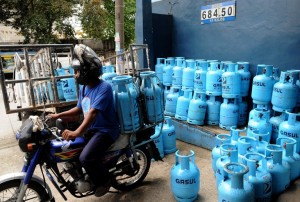Inflation seen to have picked up pace in February

The increase in consumer prices may have sped up slightly in February but remained at comfortable levels as fuel remained cheap and the supply of food stabilized. AFP FILE PHOTO
MANILA, Philippines–The increase in consumer prices may have sped up slightly in February but remained at comfortable levels as fuel remained cheap and the supply of food stabilized.
Projections by banks showed faster inflation may reflect the recent rise in fuel prices and power rates.
“Food inflation, on the other hand, continues to slow down,” Metropolitan Bank & Trust Co.’s research group said in an e-mail to the Inquirer.
Metrobank and Singapore’s DBS see February inflation at 2.5 percent.
Bank of the Philippine Islands lead economist Emilio Neri Jr., on the other hand, projected that consumer prices rose by an average of 2.6 percent.
Article continues after this advertisementThis compares to January’s 2.4 percent. The Bangko Sentral ng Pilipinas (BSP) has a forecast of 2.2 to 3 percent for the month. For all of 2015, the BSP expects inflation to average at 2.3 percent, which is near the low end of the target range of 2 to 4 percent.
Article continues after this advertisementProtecting consumers’ purchasing power by keeping prices stable is the BSP’s main goal.
This is done by adjusting interest rates and influencing the amount of cash circulating in the economy, both of which affect demand for everyday goods such as food and fuel.
Last week, BSP Governor Amando M. Tetangco Jr. said low and stable inflation gave monetary authorities space to keep benchmark interest rates steady for most of 2015.
However, Tetangco said the policymaking Monetary Board was willing to adjust its benchmark rates in any direction—up to keep in tandem with the rates overseas, or down to fend off “disinflationary” pressures.
This comes amid uncertainty over the US Federal Reserve’s plans to raise its own rates from record lows, an event that promises to affect financial markets globally.
US Fed chair Janet Yellen, speaking to lawmakers late last month, said a decision on rates would be considered on a “meeting by meeting” basis.
This dovish tone helped improve the risk appetite of global investors, favoring emerging markets like the Philippines.
Once the Fed becomes more definite on the timing of its expected policy normalization, investor sentiment may reverse and cause capital outflows from emerging markets, which may force the local central bank’s hand.